| Article ID | Journal | Published Year | Pages | File Type |
|---|---|---|---|---|
| 6293134 | Ecological Indicators | 2016 | 9 Pages |
Abstract
Heavy disturbance-induced mortality can negatively impact forest biota, functions, and services by drastically altering the forest structures that create stable environmental conditions. Disturbance impacts on forest structure can be assessed using structural sustainabilityâ¿¿the degree of balance between living and dead portions of a tree populationâ¿¿s size-class distributionâ¿¿which is the basis of baseline mortality analysis. This analysis uses a conditionally calibrated reference level (i.e., baseline mortality) against which to detect significant mortality deviations without need for historical references. Recently, a structural sustainability index was developed by parameterizing results of this analysis to allow spatial and temporal comparisons within or among forested landscapes. The utility of this index as a tool for forest health monitoring programs and triage decisions has not been examined. Here, we investigated this utility by retrospectively analyzing the structural sustainability of a mountain pine beetle (Dendroctonus ponderosae)-impacted, lodgepole pine (Pinus contorta)-dominated landscape annually from 2000 to 2006 as well as among watersheds. We show that temporal patterns of structural sustainability at the landscape-level reflect accumulating beetle-induced mortality as well as beetle-lodgepole pine ecology. At the watershed-level, this sustainability spatially varied with 2006 beetle-induced mortality. Further, structural sustainability satisfies key criteria for effective indicators of ecosystem change. We conclude that structural sustainability is a viable tool upon which to base or supplement forest health monitoring and triage programs, and could potentially increase the efficacy of such programs under current and future climate change-associated disturbance patterns.
Related Topics
Life Sciences
Agricultural and Biological Sciences
Ecology, Evolution, Behavior and Systematics
Authors
Jonathan A. Cale, Jennifer G. Klutsch, Nadir Erbilgin, José F. Negrón, John D. Castello,
